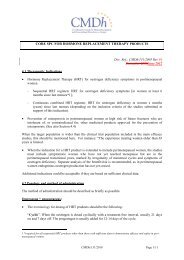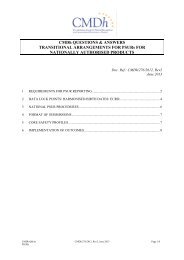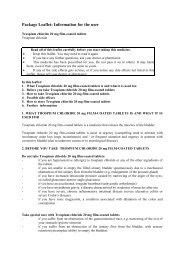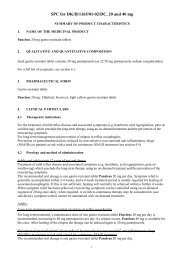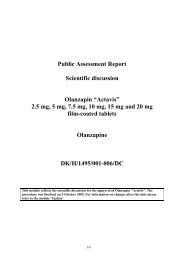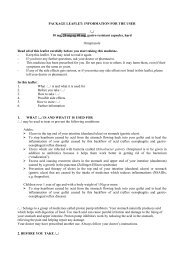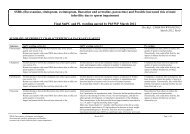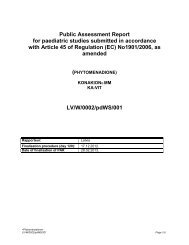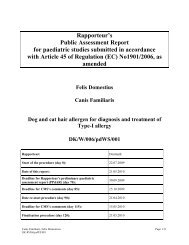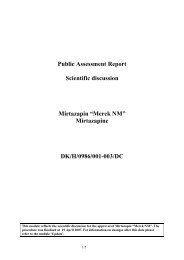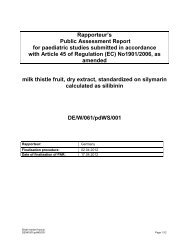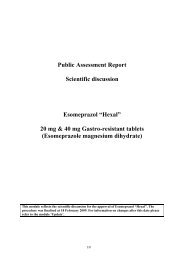ESP Pharma” 10 mg film-coated tablets Montelukast sodium DK/H/17
ESP Pharma” 10 mg film-coated tablets Montelukast sodium DK/H/17
ESP Pharma” 10 mg film-coated tablets Montelukast sodium DK/H/17
Create successful ePaper yourself
Turn your PDF publications into a flip-book with our unique Google optimized e-Paper software.
where the latter employ slightly wider related substances limits. Stability data provided to date support<br />
widening of the sulphoxide and total impurities limits to the extent suggested.<br />
Batch analysis data are provided for three pilot scale batches showing compliance with the release<br />
requirements and confirming consistency of product manufacture.<br />
Stability data are provided for 2 batches of each strength stored in the proposed market packaging. A<br />
shelf-life of 3 years when stored in the original package in order to protect from light and moisture is<br />
accepted.<br />
III. NON-CLINICAL ASPECTS<br />
This product is a generic formulation of Singulair <strong>10</strong> <strong>mg</strong> <strong>film</strong>-<strong>coated</strong> <strong>tablets</strong>, which is available on the<br />
European market. No new preclinical data have been submitted, and therefore the application has not<br />
undergone preclinical assessment. This is acceptable for this type of application<br />
Environmental risk assessment<br />
The product is intended as a substitute for other identical products on the market. The approval of this<br />
product will not result in an increase in the total quantity of montelukast <strong>sodium</strong> released into the<br />
environment. It does not contain any component, which results in an additional hazard to the<br />
environment during storage, distribution, use and disposal.<br />
IV. CLINICAL ASPECTS<br />
IV.1 Introduction<br />
<strong>Montelukast</strong> <strong>sodium</strong> is a well-known active substance with established efficacy and tolerability.<br />
For this generic application, the MAH has submitted three single dose bioequivalence studies, though<br />
two of these relate to alternative dosage forms and are therefore not directly relevant to the application<br />
and hence will not be reviewed here. The single dose study on the <strong>10</strong> <strong>mg</strong> <strong>film</strong>-<strong>coated</strong> <strong>tablets</strong> under<br />
fasting conditions compares the pharmacokinetic profile of the test product <strong>Montelukast</strong> ”<strong>ESP</strong><br />
<strong>Pharma”</strong> <strong>10</strong> <strong>mg</strong> <strong>film</strong>-<strong>coated</strong> <strong>tablets</strong> with the pharmacokinetic profile of the reference product Singulair<br />
<strong>10</strong> <strong>mg</strong> <strong>film</strong>-<strong>coated</strong> <strong>tablets</strong>, Merck Sharp & Dohme, from the German market.<br />
The study was a single centre, open label, randomised, single dose, two-way crossover study<br />
conducted under fasting conditions with a wash out period of 7 days between administrations. <strong>10</strong> <strong>mg</strong><br />
was administered in each period with 240 ml water under yellow monochromatic light, after an<br />
overnight fast of at least <strong>10</strong> hours. Subjects were confined to the clinical research centre from at least<br />
13 hours prior to drug administration until after the 24 hour post-dose blood draw in each period.<br />
Water was permitted ad lib until 1 hour before dosing and again 2 hours after dosing, otherwise ad<br />
libitum. Standardised meals were provided at 4, 8 and 12 hours post dose in each period.<br />
Blood sampling was performed predosing (within 1 hour) and at 0.5, 1.0, 1.333, 1.667, 2.0, 2.25, 2.5,<br />
2.75, 3.0, 3.5, 3.75, 4.0, 5.0, 6.0, 7.0, 8.0, 12.0, 16.0 and 24.0 hours post-dose in each period under<br />
yellow monochromatic light.<br />
36 healthy volunteers were randomised into the study and 33 completed.<br />
Primary pharmacokinetic variables were AUC0-t, AUC0-∞ and Cmax. Secondary parameters were AUC0t/AUC0-∞,<br />
tmax, Kel, and t½. Safety was also analysed.<br />
90% CIs for AUC0-t and Cmax are to be within 80-125% in order to conclude bioequivalence.<br />
4/7



